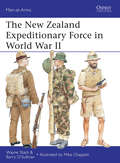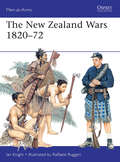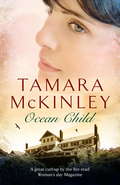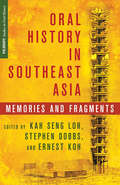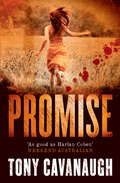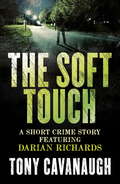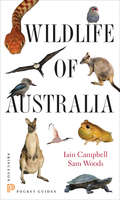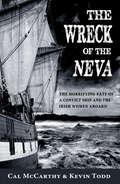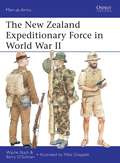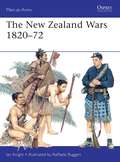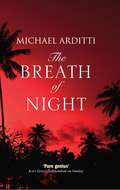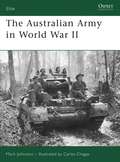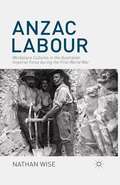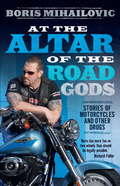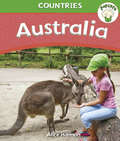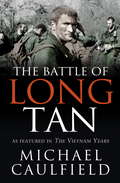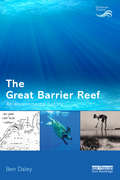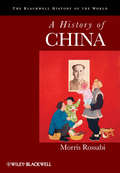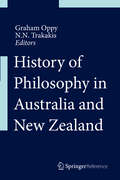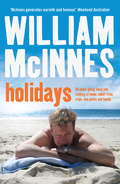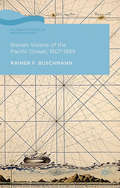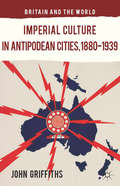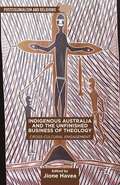- Table View
- List View
The New Zealand Expeditionary Force in World War II (Men-at-Arms #486)
by Mike Chappell Wayne Stack Barry O’SullivanIn 1939 more than 140,000 New Zealanders enlisted to fight overseas during World War II. Of these, 104,000 served in the Second New Zealand Expeditionary Force. Initially thrown into the doomed campaign to halt the German blitzkrieg on Greece and Crete (1941), the division was rebuilt under the leadership of MajGen Sir Bernard Freyberg, and became the elite corps within Montgomery's Eighth Army in the desert. After playing a vital role in the victory at El Alamein (1942) the 'Kiwis' were the vanguard of the pursuit to Tunisia. In 1943–45 the division was heavily engaged in the Italian mountains, especially at Cassino (1944); it ended the war in Trieste. Meanwhile, a smaller NZ force supported US forces against the Japanese in the Solomons and New Guinea (1942–44). Fully illustrated with specially commissioned colour plates, this is the story of the Second New Zealand Expeditionary Force's vital contribution to Allied victory in World War II.
The New Zealand Wars 1820–72 (Men-at-Arms #487)
by Ian Knight Mr Raffaele RuggeriBetween 1845 and 1872, various groups of Maori were involved in a series of wars of resistance against British settlers. The Maori had a fierce and long-established warrior tradition and subduing them took a lengthy British Army commitment, only surpassed in the Victorian period by that on the North-West Frontier of India. Warfare had been endemic in pre-colonial New Zealand and Maori groups maintained fortified villages or pas. The small early British coastal settlements were tolerated, and in the 1820s a chief named Hongi Hika travelled to Britain with a missionary and returned laden with gifts. He promptly exchanged these for muskets, and began an aggressive 15-year expansion. By the 1860s many Maori had acquired firearms and had perfected their bush-warfare tactics. In the last phase of the wars a religious movement, Pai Maarire ('Hau Hau'), inspired remarkable guerrilla leaders such as Te Kooti Arikirangi to renewed resistance. This final phase saw a reduction in British Army forces. European victory was not total, but led to a negotiated peace that preserved some of the Maori people's territories and freedoms.
Ocean Child
by Tamara McKinley1920. Having disobeyed the wishes of her aristocratic family, Lulu Pearson, a young and talented Tasmanian sculptress, finds herself alone in London in the wake of the Great War. The future is looking bright until, on the eve of her first exhibition, Lulu learns she has inherited a racing colt called Ocean Child from a mysterious benefactor, and she must return to her homeland to claim him. Baffled by the news, Lulu boards a ship to Tasmania to uncover the truth behind the strange bequest, but it seems a welcome return is more than she can hope for. Unbeknownst to Lulu, more than a few fortunes ride on Ocean Child's success - it seems everyone from her estranged mother to the stable hands has a part to play, and an interest in keeping the family secrets buried.
Oral History in Southeast Asia: Memories and Fragments (Palgrave Studies in Oral History)
by Kah Seng Loh, Stephen Dobbs, and Ernest KohUsing the presence of the past as a point of departure, this books explores three critical themes in Southeast Asian oral history: the relationship between oral history and official histories produced by nation-states; the nature of memories of violence; and intersections between oral history, oral tradition, and heritage discourses.
Promise: Promise And Dead Girl Rising (The Darian Richards Series #1)
by Tony CavanaughAn Australian crime thriller 'as good as Harlan Coben' - Weekend Australian.A serial killer is stalking the Sunshine Coast. Girls have vanished. All blonde and pretty. Ex homicide investigator Darian Richards knows they are dead even though the cops keep saying 'missing'. That's what you have to say if you don't have a body.Jenny Brown was the first. The local cops said runaway. Then others disappeared. They couldn't all be runaways.This killer knows how to stay under the radar, how to hide in plain sight. He knows how to hunt, hurt and kill. Darian has seen evil like him before and knows what it takes to make it stop. He'll make sure the killer gets what he deserves... and that's a promise. A devastatingly brilliant crime novel that gives us a horrifying glimpse into the mind of a diabolical killer and introduces us to one of the most complex and uncompromising heroes since Harry Bosch.Tony Cavanaugh is an Australian writer and producer of film and television with over thirty years' experience in the industry. His new novel, Dead Girl Sing also features former cop Darian Richards and is on sale now.'Never relinquishes its hold on your nerves' - Canberra Times'Couldn't stop reading it. One of the freshest and most well-written novels I've come across this year' - Graeme Blundell, crime reviewer, The Australian 'The best thing about this book is that it looks like there will be a second one' - Australian Bookseller & Publisher'Compulsive reading, Promise itself is more menacing, more disturbing and much more confronting than any other crime thriller on the shelves. It is brutal. It is terrifying. It is a brilliant book' - Rob Monshull, Weekends Producer, ABCThe Darian Richards SeriesPromiseDead Girl SingThe Soft Touch (Short Story)The Train RiderKingdom of the Strong
The Soft Touch
by Tony CavanaughA gripping short crime story featuring Darian Richards by Australia's bestselling debut crime writer Tony Cavanaugh. Includes previews of his first two full-length novels.[Cavanaugh's debut is] 'as good as Harlan Coben' - Weekend Australian.Darian Richards is a retired homicide investigator. He was one of the best. But chasing monsters eventually took its toll and he quit the force to sit on a jetty on the Noosa River. Or so he planned.After years of service, witnessing the best and the worst of policing, Darian has made up his own mind about justice. Whenever a horrific crime is committed debate rages about the nature of punishment. As far as the law is concerned justice doesn't condone revenge, but tell that to the family of a murder victim or to the woman you can't protect. Darian Richards knows that in the real world, when your hands are tied, sometimes revenge is the only justice.The Soft Touch takes you deep into Darian's past, to the life lessons that made him who he is. He is a man you want looking out for you not looking for you.The Darian Richards SeriesPromiseDead Girl SingThe Soft Touch (Short Story)The Train RiderKingdom of the Strong
Wildlife of Australia
by Iain Campbell Sam WoodsIdeal for the nature-loving traveler, Wildlife of Australia is a handy photographic pocket guide to the most widely seen birds, mammals, reptiles, amphibians, and habitats of Australia. The guide features more than 400 stunning color photographs, and coverage includes 350 birds, 70 mammals, 30 reptiles, and 16 frogs likely to be encountered in Australia's major tourist destinations. Accessible species accounts are useful for both general travelers and serious naturalists, and the invaluable habitat section describes the Australian bush and its specific wildlife. Animal species with similar features are placed on the same plates in order to aid identification. Wildlife of Australia is an indispensable and thorough resource for any nature enthusiast interested in this remarkable continent. Easy-to-use pocket guide More than 400 high-quality photographs Accessible text aids identification Habitat guide describes the Australian bush and its specific wildlife Coverage includes the 350 birds, 70 mammals, 30 reptiles, and 16 frogs most likely to be seen on a trip around Australia
The Wreck of the Neva: The Horrifying Fate of a Convict Ship and the Women Aboard
by Cal McCarthy Kevin ToddThe 'Neva' sailed from Cork on 8 January 1835, destined for the prisons of Botany Bay. There were 240 people on board, most of them either female convicts or the wives of already deported convicts, and their children. On 13 May 1835 the ship hit a reef just north of King's Island in Australia and sank with the loss of 224 lives - one of the worst shipwrecks in maritime history. The authors have comprehensively researched sources in Ireland, Australia and the UK to reconstruct in fascinating detail the stories of these women. Most perished beneath the ocean waves, but for others the journey from their poverty stricken and criminal pasts continued towards hope of freedom and prosperity on the far side of the world. At a time when Australia is once again becoming a new home for a generation of migrating Irish, it is appropriate that the formative historical links between the two countries be remembered.
The New Zealand Expeditionary Force in World War II (Men-at-Arms)
by Mike Chappell Wayne Stack Barry O’SullivanIn 1939 more than 140,000 New Zealanders enlisted to fight overseas during World War II. Of these, 104,000 served in the Second New Zealand Expeditionary Force. Initially thrown into the doomed campaign to halt the German blitzkrieg on Greece and Crete (1941), the division was rebuilt under the leadership of MajGen Sir Bernard Freyberg, and became the elite corps within Montgomery's Eighth Army in the desert. After playing a vital role in the victory at El Alamein (1942) the 'Kiwis' were the vanguard of the pursuit to Tunisia. In 1943–45 the division was heavily engaged in the Italian mountains, especially at Cassino (1944); it ended the war in Trieste. Meanwhile, a smaller NZ force supported US forces against the Japanese in the Solomons and New Guinea (1942–44). Fully illustrated with specially commissioned colour plates, this is the story of the Second New Zealand Expeditionary Force's vital contribution to Allied victory in World War II.
The New Zealand Wars 1820–72 (Men-at-Arms)
by Raffaele Ruggeri Ian KnightBetween 1845 and 1872, various groups of Maori were involved in a series of wars of resistance against British settlers. The Maori had a fierce and long-established warrior tradition and subduing them took a lengthy British Army commitment, only surpassed in the Victorian period by that on the North-West Frontier of India. Warfare had been endemic in pre-colonial New Zealand and Maori groups maintained fortified villages or pas. The small early British coastal settlements were tolerated, and in the 1820s a chief named Hongi Hika travelled to Britain with a missionary and returned laden with gifts. He promptly exchanged these for muskets, and began an aggressive 15-year expansion. By the 1860s many Maori had acquired firearms and had perfected their bush-warfare tactics. In the last phase of the wars a religious movement, Pai Maarire ('Hau Hau'), inspired remarkable guerrilla leaders such as Te Kooti Arikirangi to renewed resistance. This final phase saw a reduction in British Army forces. European victory was not total, but led to a negotiated peace that preserved some of the Maori people's territories and freedoms.
The Breath of Night
by Michael ArdittiPhilip Seward travels to the Philippines to investigate the case of a missionary priest imprisoned for murder, where he is drawn into a labyrinth of vice, violence, and corruption where nothing and nobody are what they seem.'Part Conrad, part Waugh, part Greene, and pure genius' Independent on Sunday'This is Arditti's most dazzling novel to date because of the scale of his ambition and his triumph in pulling it off' Peter Stanford, Daily TelegraphWhile working as a missionary priest in the Philippines during the Marcos dictatorship, Julian Tremayne championed the Communist rebels and found himself imprisoned for murder. Now, three decades later, following Julian's death, a cult develops around him, even calling for sainthood. When Philip Seward goes to investigate on behalf of Julian's family, he is drawn into a labyrinth of vice, violence, and corruption where nothing and nobody are what they seem. Enriched by a gallery of engaging characters ranging from priests to prostitutes, GIs to gangsters, and street children to Imelda Marcos, this outstanding novel is at once a gripping psychological thriller, a challenging moral mystery, and an unforgettable voyage into a dark and exotic landscape.
The Australian Army in World War II (Elite)
by Mark Johnston Carlos ChagasThis book recounts the organization and deployment of one of the most important fighting armies of World War II. Australian divisions made a large and distinctive contribution to victory both in the deserts of the Middle East and the jungles of the South-West Pacific,earning for the second time a unique reputation for aggressiveness, endurance and independence of spirit. The text is illustrated with original wartime photos from all fronts; and with full colour plates showing a wide range of uniforms and gear, together with the complex and colourful Australian system of unit insignia.
Anzac Labour: Workplace Cultures in the Australian Imperial Force during the First World War
by Nathan WiseAnzac Labour explores the horror, frustration and exhaustion surrounding working life in the Australian Imperial Force during the First World War. Based on letters and diaries of Australian soldiers, it traces the history of work and workplace cultures through Australia, the shores of Gallipoli, the fields of France and Belgium, and the Near East.
At the Altar of the Road Gods: Stories of motorcycles and other drugs
by Boris MihailovicCaution: Contains incidents of insane motorcycle antics, drug use and swearing.'Boris has more fun on two wheels than should be legally possible.' - Richard Fidler, ABCHis mother may not know it but Boris Mihailovic has lived a fast, furious, often politically incorrect life chasing the epiphanies of speed (the sensation not the drug). For Boris, motorbike riding was the rite of passage into manhood he'd been searching for. Now, nearly 40 years since he first rode a bike, the wisdom of age has provided the perspective for Boris to look back and realise some pretty wild shit went down. At the Altar of the Road Gods is about popping your motorcycle-buying cherry with an XJ650 Yamaha. It's about fines, feuds and fractures, high-sides, tank-slappers, angry police, even angrier young men, crashing, getting up, cranky girlfriends, riding faster, outlaws, and partaking in copious amounts of alcohol and drugs. It is about mateship and motorcycles. Ultimately, it is about four decades of two-wheel-related mayhem. Just don't tell Boris's mum! Be warned: may cause laughter, sleeplessness and the desire to buy a Lucifer-black Katana.
Australia: Australia (Popcorn: Countries #11)
by Alice HarmanFind out about the people and places of Australia in this fun and interactive beginners book about the country.
The Battle of Long Tan: As featured in The Vietnam Years
by Michael CaulfieldThe truth about the battle that came to define our Vietnam War - from the men who were there.18th August, 1966. 1pm…D Company entered the plantation. They thought that, if they were lucky, they were closing in on perhaps 30 or 40 VC. They were horribly wrong.Over twelve long, bloody and brutal hours, 105 Australian soldiers and three New Zealanders fought off mortar attacks and heavy machine-gun fire, unaware they were facing up to 2500 Viet Cong and North Vietnamese forces. The first major battle of the war for the Australians, our men showed extraordinary courage and, against all odds, they triumphed – although the Vietnamese didn't admit this for another forty years.In The Battle of Long Tan, Caulfield takes us through that hellish day in the Long Tan rubber plantation, combining gripping first-hand accounts from eleven of the men who fought with an authoritative overview of the battle itself – from headquarters to the men in the field.This is as close as you'll get to being there.Michael Caulfield has worked as a composer, musician, TV and film producer, and director. He was the executive producer of the ABC TV series Australians at War. His books with Hachette Australia include The Vietnam Years, War behind the Wire and Voices of War.
The Great Barrier Reef: An Environmental History (Earthscan Oceans)
by Ben DaleyThe Great Barrier Reef is located along the coast of Queensland in north-east Australia and is the world's largest coral reef ecosystem. Designated a World Heritage Area, it has been subject to increasing pressures from tourism, fishing, pollution and climate change, and is now protected as a marine park. This book provides an original account of the environmental history of the Great Barrier Reef, based on extensive archival and oral history research. It documents and explains the main human impacts on the Great Barrier Reef since European settlement in the region, focusing particularly on the century from 1860 to 1960 which has not previously been fully documented, yet which was a period of unprecedented exploitation of the ecosystem and its resources. The book describes the main changes in coral reefs, islands and marine wildlife that resulted from those impacts. In more recent decades, human impacts on the Great Barrier Reef have spread, accelerated and intensified, with implications for current management and conservation practices. There is now better scientific understanding of the threats faced by the ecosystem. Yet these modern challenges occur against a background of historical levels of exploitation that is little-known, and that has reduced the ecosystem's resilience. The author provides a compelling narrative of how one of the world's most iconic and vulnerable ecosystems has been exploited and degraded, but also how some early conservation practices emerged.
The Great Barrier Reef: An Environmental History (Earthscan Oceans)
by Ben DaleyThe Great Barrier Reef is located along the coast of Queensland in north-east Australia and is the world's largest coral reef ecosystem. Designated a World Heritage Area, it has been subject to increasing pressures from tourism, fishing, pollution and climate change, and is now protected as a marine park. This book provides an original account of the environmental history of the Great Barrier Reef, based on extensive archival and oral history research. It documents and explains the main human impacts on the Great Barrier Reef since European settlement in the region, focusing particularly on the century from 1860 to 1960 which has not previously been fully documented, yet which was a period of unprecedented exploitation of the ecosystem and its resources. The book describes the main changes in coral reefs, islands and marine wildlife that resulted from those impacts. In more recent decades, human impacts on the Great Barrier Reef have spread, accelerated and intensified, with implications for current management and conservation practices. There is now better scientific understanding of the threats faced by the ecosystem. Yet these modern challenges occur against a background of historical levels of exploitation that is little-known, and that has reduced the ecosystem's resilience. The author provides a compelling narrative of how one of the world's most iconic and vulnerable ecosystems has been exploited and degraded, but also how some early conservation practices emerged.
A History of China (Blackwell History of the World)
by Morris RossabiCapturing China’s past in all its complexity, this multi-faceted history portrays China in the context of a larger global world, while incorporating the narratives of Chinese as well as non-Chinese ethnic groups and discussing people traditionally left out of the story—peasants, women, merchants, and artisans. Offers a complete political, economic, social, and cultural history of China, covering the major events and trends Written in a clear and uncomplicated style by a distinguished historian with over four decades of experience teaching undergraduates Examines Chinese history through the lens of global history to better understand how foreign influences affected domestic policies and practices Depicts the role of non-Chinese ethnic groups in China, such as Tibetans and Uyghurs, and analyzes the Mongol and Manchu rulers and their impact on Chinese society Incorporates the narratives of people traditionally left out of Chinese history, including women, peasants, merchants, and artisans
A History of China (Blackwell History of the World)
by Morris RossabiCapturing China’s past in all its complexity, this multi-faceted history portrays China in the context of a larger global world, while incorporating the narratives of Chinese as well as non-Chinese ethnic groups and discussing people traditionally left out of the story—peasants, women, merchants, and artisans. Offers a complete political, economic, social, and cultural history of China, covering the major events and trends Written in a clear and uncomplicated style by a distinguished historian with over four decades of experience teaching undergraduates Examines Chinese history through the lens of global history to better understand how foreign influences affected domestic policies and practices Depicts the role of non-Chinese ethnic groups in China, such as Tibetans and Uyghurs, and analyzes the Mongol and Manchu rulers and their impact on Chinese society Incorporates the narratives of people traditionally left out of Chinese history, including women, peasants, merchants, and artisans
Holidays: All About Going Away And Staying At Home, About Train Trips, Lion Parks And Family
by William McInnesFrom bestselling author William McInnes, a book about the languid, unending holidays of summer; it's about going away and staying at home, about sunburn, seagulls, family and friends.Remember those long, languid holidays when the only decisions to be made were what to pack in the Esky and who should get the front seat on the drive to the beach?Let William McInnes reignite your nostalgia for holidays past, and give you a taste of the boundless opportunities that await in holidays to come in this book about our love affair with life away from the everyday.This book will take you back to the holidays you had as a kid and remind you of the ones you've had with your own family or friends or even the ones where you've flown solo.Holidays are the runway to possibilities - a romantic sunset, the spare seat at breakfast being taken by an attractive stranger, a miraculous airline upgrade - or missing bags, unfortunate rashes and wrong turns that lead to places you definitely did not intend to go. Whether you are away from home and somewhere exotic or just in your own backyard on a lilo in an above-ground pool, whatever happens, you know that life is sweet because you're on HOLIDAYS.**Includes a bonus extract from William's hilarious and heartwarming memoir Fatherhood**"McInnes is a natural storyteller . . ." - Sun Herald, Sydney"McInnes enjoys a quirky love affair with the quintessential Australian holiday" - Brisbane News"Proves that the journey is just as agreeable as the destination" - Sunday Age". . . full of beautifully crafted childhood reminiscences and anecdotes" - Sunday Examiner"McInnes is a wonderfully engaging writer - witty and warm and a master of a good yarn. If your holidays aer a way off, curl up with William and he'll take you away" - Adelaide Advertiser
Iberian Visions of the Pacific Ocean, 1507-1899 (Palgrave Studies in Pacific History)
by R. BuschmannIn this work, Buschmann incorporates neglected Spanish visions into the European perceptions of the emerging Pacific world. The book argues that Spanish diplomats and intellectuals attempted to create an intellectual link between the Americas and the Pacific Ocean.
Imperial Culture in Antipodean Cities, 1880-1939 (Britain and the World)
by J. GriffithsDrawing on a wealth of primary and secondary sources, this book explores how far imperial culture penetrated antipodean city institutions. It argues that far from imperial saturation, the city 'Down Under' was remarkably untouched by the Empire.
Indigenous Australia and the Unfinished Business of Theology: Cross-Cultural Engagement (Postcolonialism and Religions)
by Jione HaveaThis book engages a complex subject that mainline theologies avoid, Indigenous Australia. The heritages, wisdoms and dreams of Indigenous Australians are tormented by the discriminating mindsets and colonialist practices of non-Indigenous peoples. This book gives special attention to the torments due to the arrival and development of the church.
